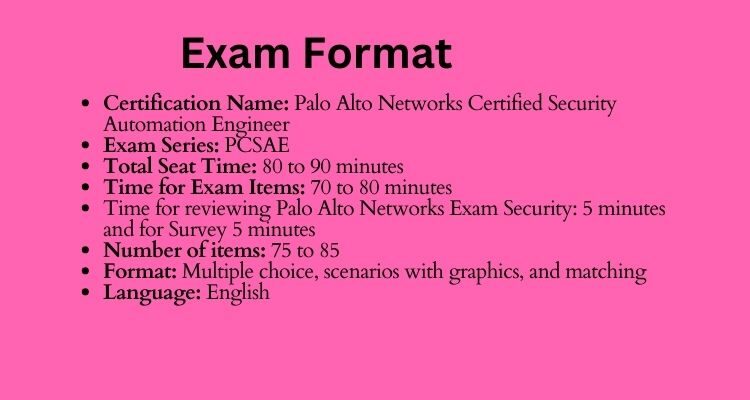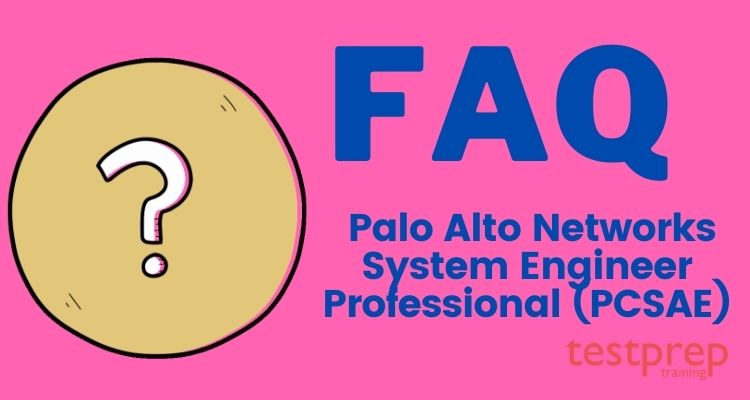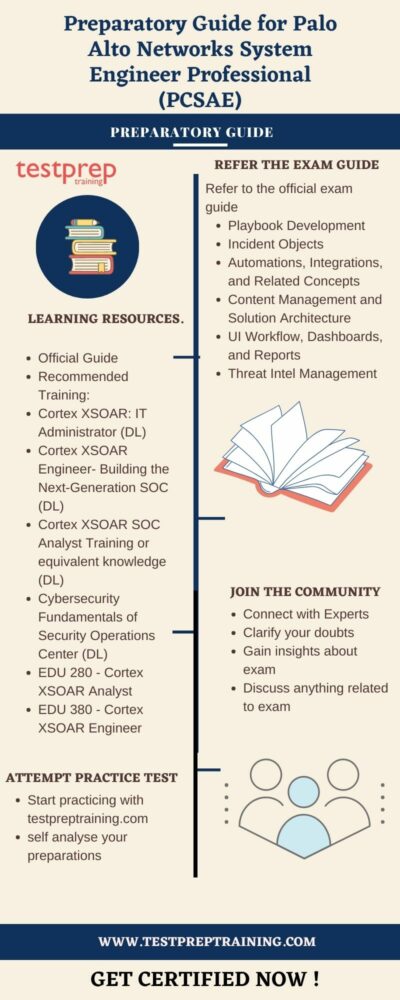Palo Alto Networks System Engineer Professional (PCSAE)

The Palo Alto Networks System Engineer Professional (PCSAE) certification verifies the expertise needed to design, evaluate, and manage the native threat intelligence management Cortex XSOAR security orchestration, automation, and response platform. It demonstrates that engineers are capable of appropriately appreciating the value of pre-made and bespoke playbooks and integrations. They can also recognize customer operations that XSOAR can automate, and they are skilled at customizing XSOAR to shorten the mean time to resolution while utilizing the rest of their security offerings.
What are the target audience for the examination?
Customers, partners, system engineers, analysts, and administrators are all welcome to participate in the demonstration of knowledge, skills, and abilities using Palo Alto Networks Cortex XSOAR capability.
Exam Format

How to register for the examination?
The test can be taken through the independent Pearson VUE testing facility. Visit to sign up for the test.
For more information, click on Palo Alto Networks System Engineer Professional (PCSAE) FAQ.

Course Outline for Palo Alto Networks System Engineer Professional (PCSAE)
Playbook Development
- Reference and manipulate context data to manage automation workflow
- Summarize inputs, outputs, and results for playbook tasks
- Configure Inputs and Outputs for Sub-playbooks Tasks
- Enable and Configure Looping on a Sub-playbook
- Differentiate among Playbook Task Types
- Manual
- Automated
- Conditional
- Data Collection
- Sub-Playbook
- Apply filters and transformers to manipulate data
- Apply the Playbook Debugger to Aid in Development Playbooks
- Summary of Key Ideas
Incident Objects
- Configure Incident Types
- Identify the Role of an Incident Type within the Incident Lifecycle
- Configure an Incident Layout
- Fields and Buttons
- Tabs
- New/Edit and Close Forms
- Summarize the Function, Capabilities, and Purpose of Incident Fields
- Configure Classifier and Mappers
- Summary of Key Ideas
Automations, Integrations, and Related Concepts
- Define the Capabilities of Automation across XSOAR Functions
- Playbook Tasks
- War Room
- Layouts (Dynamic Sections, Buttons)
- Jobs
- Field Trigger Scripts
- Pre/Post-Processing
- Differentiate between Automations, Commands, and Scripts
- Interpret and Modify Automation Scripts
- Script Helper
- Script Settings
- Language Types
- Using Script to Create Widget for Dashboards
- Identify the Properties and Capabilities of the XSOAR Framework for Integration
- Configure and Manage Integration Instances
- Summary of Key Ideas
Content Management and Solution Architecture
- Apply Marketplace Concepts for the Management of Content
- Searching in Marketplace
- Installation and Updates
- Dependencies
- Version History
- Partner-supported Versus XSOAR-supported
- Submitting Content to the Marketplace
- Apply General Content Customization and Management Concepts
- Custom versus System Content
- Duplicating Content
- Importing/Exporting Custom Content
- Version Control
- Manage Local Changes in a Remote Repository (dev-prod) Configuration
- Describe the Components of the XSOAR System Architecture
- System Hardware Requirements
- Remote Repositories (dev-prod)
- Engines
- Multi Tenancy
- Elasticsearch/HA
- Docker
- Describe the Incident Lifecycle within XSOAR
- Define the Capabilities of RBAC
- Page Access
- Integration Permissions
- Incident Tabs (Layout Specification)
- Automation Permissions
- Incident Viewing Permission by Role
- Identify the Troubleshooting Tools Available to Obtain More Diagnostic Information
- Log Bundles
- Integration Testing
- Identify Options Available for Performance Tuning
- Ignore Output
- Quiet Mode
- Monitor System Health using the System Diagnostic Page
UI Workflow, Dashboards, and Reports
- Identify Methods for Querying Data
- Indicators
- Incidents
- Dashboards
- Global Search
- Summarize the Workflow Elements used during an Investigation
- Layouts
- War Room
- Work Plan
- Evidence Board
- Actions Menu
- Interact with Layouts for Incident Management
- Sections
- Fields
- Buttons
- Summarize Tools used for Managing Incidents
- Bulk Incident Actions
- Table View versus Summary View
- Table Settings
- Identify the Capabilities of Existing Dashboards and Reports
- Summarize what Information can be Created, Edited, or Shared within Dashboards and Reports
- Summarize the Capabilities of the Widget Builder
Threat Intel Management
- Identify the Parameters Available for Configuring Indicator Objects
- Layouts and Types
- Reputation Scripts and Command
- Expiration
- Generate Threat Intel Reports
- Describe the Features of the Threat Intel Page
- Unit 42 Intel Feature
- XSOAR Indicators
- Export/Import Capabilities
- Configure Threat Intel Feed Integrations
- Identify the Options Available to Auto Extract
- Exclusion List
- Playbook Auto Extract
- Regex for Auto Extract
- System Defaults
- Extraction Settings for Incident Types
Preparatory Guide: Palo Alto Networks System Engineer Professional (PCSAE)

Official Study Guide and Exam Objectives
You will be more effective at studying and more dependable in your study sessions if you read the approved study guide. As you gain experience, you’ll learn which areas you are skilled in and which ones require more practice to master.Prior to each exam, it is recommended that you review and check the official exam guide. In order to make sure you are adequately prepared for the exam, Palo Alto provides certified study resources and an exam guide. Reviewing the essential exam information is now necessary. In order to aid you in your preparation, we have created a list of exam objectives that you can refer to:
- Playbook Development
- Incident Objects
- Automations, Integrations, and Related Concepts
- Content Management and Solution Architecture
- UI Workflow, Dashboards, and Reports
- Threat Intel Management
Official Palto Alto Training
Palto Alto provides preparation materials for the Palo Alto Networks System Engineer Professional (PCSAE) exam. With this official program, you will learn all the domains and modules required to pass the exam. To pass the test, it is advised that you put this training into practice.
Recommended Training
The following instructor-led training sessions, or equivalent online training, are highly advised by Palo Alto Networks.
- Cortex XSOAR: IT Administrator (DL)
- Cortex XSOAR Engineer- Building the Next-Generation SOC (DL)
- Cortex XSOAR SOC Analyst Training or equivalent knowledge (DL)
- Cybersecurity Fundamentals of Security Operations Center (DL)
- EDU 280 – Cortex XSOAR Analyst
- EDU 380 – Cortex XSOAR Engineer
Join Study groups
A fantastic method to fully commit to the certification exam you applied for is to join study groups. You might benefit from their assistance in staying up to date on any recent exam modifications or revisions. These clubs house both amateurs and professionals. Without fear of reprimand, you are free to discuss the test or ask any questions about it. You are also free to start a discourse here about any exam-related issue or question. If you take these actions, you will get the best answer to your query.
Practice Tests
To evaluate your results, you must put what you have learnt into practice. Practice will help you become more adept at responding, which will save you a lot of time. Furthermore, it is recommended to begin practice exams once you have done studying for a single topic because they will serve as a revision assistance for you. Get started practicing with free sample test questions!

